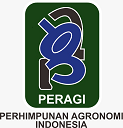The Effect of Allelochemical of Parthenium hysterophorus L., Eucalyptus creba F. Muell., and Casuarina cunninghamiana Miq. on the Germination and Seedling Growth of Lepidium sativum L.
Abstract
Allelochemicals are widely known to have antagonistic effects on the environment by inhibiting the physiological activities of other plants. However, this is the whole characteristic of allelochemicals since their effects are not only limited to inhibiting. In low concentration, allelochemicals could have a promoting effect on other plants especially on the germination and seedling stage. This research was conducted to examine the allelochemical activity of Parthenium hysterophorus L., Eucalyptus creba F. Muell., and Casuarina cunninghana Miq. on Lepidium sativum L. with the sandwich method. The leaves of parthenium, eucalyptus, and casuarina were dried and layered between two 5 mL agar in multi well plates and the sterilized seeds of Lepidium sativum L. were set to germinate on the agar. The results showed that the leaves of parthenium, eucalyptus, and casuarina caused lower germination rate compared to the control treatment but led to the greater shoot and root length of Lepidium sativum.
Keywords
Full Text:
PDFReferences
Abdul Raoof, K. M., & Siddiqui, M. B. (2013). Allelotoxic effect of parthenin on cytomorphology of broad bean (Vicia faba L.). Journal of the Saudi Society of Agricultural Sciences, 12(2), 143–146. https://doi.org/https://doi.org/10.1016/j.jssas.2012.11.001
Allaby, M. (2012). A Dictionary of Plant Sciences. Oxford University Press.
Bajwa, A. A., Nguyen, T., Navie, S., O’Donnell, C., & Adkins, S. (2018). Weed seed spread and its prevention: The role of roadside wash down. Journal of Environmental Management, 208, 8–14. https://doi.org/https://doi.org/10.1016/j.jenvman.2017.12.010
Batish, D. R., Singh, H. P., & Kohli, R. k. (2001). Vegetation exclusion under Casuarina Equisetifolia L.: Does allelopathy play a role? Community Ecology, 2(1), 93–100.
Belz, R. G. (2008). Stimulation versus inhibition-bioactivity of parthenin, a phytochemical from parthenium hysterophorus L. Dose-Response, 6(1), 80–96. https://doi.org/10.2203/dose-response.07-007.Belz
Belz, R. G., Reinhardt, C. F., Foxcroft, L. C., & Hurle, K. (2007). Residue allelopathy in Parthenium hysterophorus L.—Does parthenin play a leading role? Crop Protection, 26(3), 237–245. https://doi.org/https://doi.org/10.1016/j.cropro.2005.06.009
Ben Ghnaya, A., Hamrouni, L., Amri, I., Ahoues, H., Hanana, M., & Romane, A. (2016). Study of allelopathic effects of Eucalyptus erythrocorys L. crude extracts against germination and seedling growth of weeds and wheat. Natural Product Research, 30(18), 2058–2064. https://doi.org/10.1080/14786419.2015.1108973
El-Darier, S. M. (2002). Allelopathic effects of Eucalyptus rostrata on growth, nutrient uptake and metabolite accumulation of Vicia faba L. and Zea mays L. Pakistan Journal of Biological Sciences, 5(1), 6–11.
Evans, H. (1997). parthenium hysterophorus. a review of its weed status and the possibilities for biological control. Biocontrol News and Information, 18(3), 89–98.
Ferguson, J., & Rathinasabapathi, B. (2003). Allelopathy: How plants surpress other plants.
Fujii, Y., Shibuya, T., Nakatani, K., Itani, T., Hiradate, S., & Parvez, M. (2004). Assessment method for allelpathic effect from leaf litter leachates. Weed Biology and Management, 4(1), 19–23.
Inderjit, & Duke, S. O. (2003). Ecophysiological aspects of allelopathy. Planta, 217(4), 529–539. https://doi.org/10.1007/s00425-003-1054-z
Kaur, S., Singh, H. P., Batish, D. R., & Kohli, R. K. (2011). Chemical characterization and allelopathic potential of volatile oil of Eucalyptus tereticornis against Amaranthus viridis. Journal of Plant Interactions, 6(4), 297–302. https://doi.org/10.1080/17429145.2010.539709
Khaket, T. P., Singh, M., Dhanda, S., Singh, T., & Singh, J. (2012). Biochemical characterization of consortium compost of toxic weeds Parthenium hysterophorus and Eichhornia crassipe. Bioresource Technology, 123, 360–365. https://doi.org/https://doi.org/10.1016/j.biortech.2012.07.107
Kishor, P., Ghosh, A. K., Singh, S., & Maurya, B. R. (2010). potential use of parthenium (Parthenium hysterophorus L.) in agriculture. Asian Journal of Agricultural Research, 4(4), 220–225.
Kobayashi, K. (2004). Factors affecting phytotoxic activity of allelochemicals in soil. Weed Biology and Management, 4(1), 1–7. https://doi.org/https://doi.org/10.1111/j.1445-6664.2003.00112.x
Patel, S. (2011). Harmful and beneficial aspects of Parthenium hysterophorus: an update. 3 Biotech, 1(1), 1–9. https://doi.org/10.1007/s13205-011-0007-7
Rice, E. L. (1984). Allelopathy. Academic Press, Inc.
Singh, H. P., Batish, D. R., Pandher, J. K., & Kohli, R. K. (2003). Assessment of allelopathic properties of Parthenium hysterophorus residues. Agriculture, Ecosystems & Environment, 95(2), 537–541. https://doi.org/https://doi.org/10.1016/S0167-8809(02)00202-5
Refbacks
- There are currently no refbacks.



























